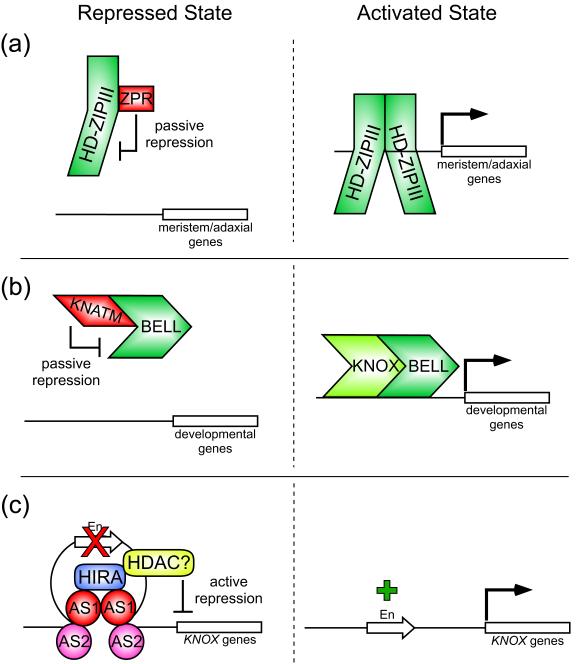Figure 2.
Transcriptional repression mechanisms in developmental responses.
(a) Passive repression of HD-ZIPIII target genes.
(Left) ZPR proteins physically interact with HD-ZIPIII transcription factors through shared ZIP domains, preventing HD-ZIPIII/HD-ZIPIII dimerization [48**,49**]. Since HD-ZIPIII/HD-ZIPIII dimerization appears necessary for DNA binding [44-47], target genes are passively repressed.
(Right) In the absence of ZPR association with HD-ZIPIII transcription factors, the latter are able to dimerize, bind DNA, and activate targets, including genes involved in specifying meristem and adaxial identity [41-43].
(b) Passive repression of TALE homeodomain-mediated gene expression.
(Left) KNATM directly binds TALE homeodomain proteins, such as BELL transcription factors, and is proposed to render them inactive and/or sequester them in the cytoplasm [50**].
(Right) In the absence of repressive KNATM interactions, BELL proteins are able to enter the nucleus and/or bind gene targets. This may involve association with members of the KNOX family of transcriptional regulators, which have been shown to dimerize with BELL factors [89-91].
(c) Active repression of KNOX expression.
(Left) DNA recognition sites for AS1/AS2 heterodimers are present at two positions in the promoters of KNOX genes KNAT1/BP and KNAT2. Upon DNA-binding, heterodimers are proposed to associate with one another, likely due in part to the ability of AS1 to bind itself, resulting in a “looping” of the intervening promoter DNA [54,55**]. AS1 can also physically associate with the chromatin remodeling factor HIRA which plays a role in gene silencing [54,62-64], potentially due to interaction with HDACs [65]. This protein complex is predicted to produce a repressive chromatin state in this region of KNOX promoters, leading to the silencing of transcriptional enhancer (En) elements in the vicinity. These events are believed to effectively maintain KNOX gene silencing in domains of AS1/AS2 function, including leaf primoridia.
(Right) In the absence of AS1/AS2 activity, transcriptional enhancer elements in KNOX promoters are able to induce gene expression.

